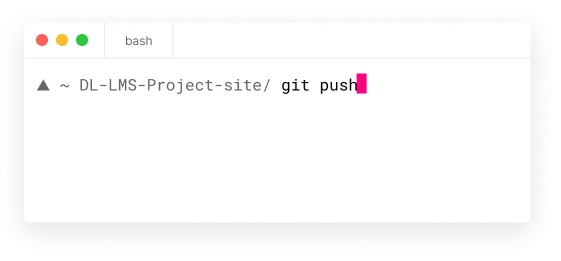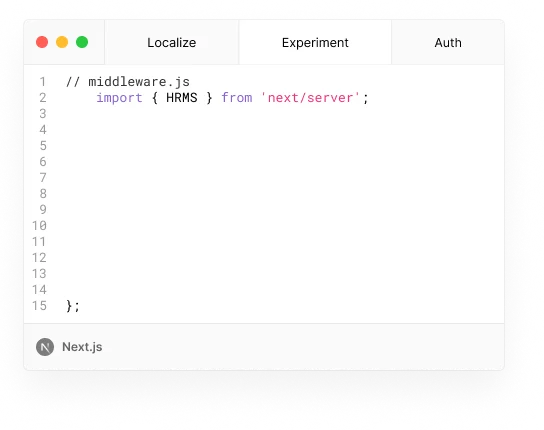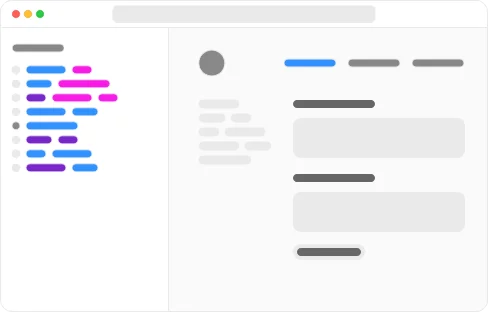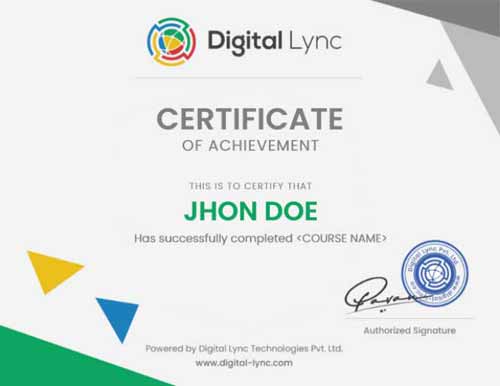Learn from Curated Curriculums developed by Industry Experts
Topics:
1. What is an Application?
Overview of applications and their significance.
2. Types of Applications
Classification and examples of various application types.
3. Fundamentals of Web Applications
Basic concepts and components of web applications.
4. Web Application Architecture
Structure and design patterns in web application architecture.
5. Web Technologies used in Projects
Key technologies and frameworks used in web application development.
Topics
1. Introduction to Software Development Life Cycle
The phases, importance, and overview of SDLC.
2. Application Lifecycle Management - ALM
Tools, processes, and overview of ALM.
3. SDLC Methodologies
Examination of different methodologies used in software development.
4. DevOps Process
Understanding the principles, practices, and benefits of DevOps.
Topics
1. Introduction To Agile & Scrum
Fundamental overview of Agile methodologies and the Scrum framework.
2. The Principles of Agile Methodology
Core principles of Agile focusing on iterative development and customer collaboration.
3. Scrum Framework: Roles, Artifacts, and Events
Key components of Scrum, including its roles, artifacts, and structured events.
4. Implementing Agile with Scrum
Strategies for applying Agile and Scrum practices in software development projects.
5. Agile Project Management Best Practices
Essential practices for leading Agile projects, emphasizing communication and continuous improvement.
Overview of Analytics and Power BI Tools Suite
Career Opportunities and Job Roles in Power BI
Power BI Data Analyst (PL 300) Certification Overview
Introduction to AI Visuals and Features in Power BI
Understanding the Power BI Ecosystem and Architecture
Data Sources and Types for Power BI Reporting
Power BI Design Tools and Desktop Tool Installation
Exploring Power BI Desktop Interface: Data View, Report View, and Canvas
Visual Interaction Techniques in Reports
Using Slicers for Dynamic Report Filtering
Managing Report Pages and Visual Sync Limitations
Implementing Grouping and Binning in Reports
Creating and Utilizing Hierarchies for Drill-Down Reports
Introduction to Power Query M Language
Basic Data Transformations in Power Query
Understanding Query Duplication and Grouping
Overview of Power BI Cloud Components and App Workspaces
Creating and Managing Reports and Dashboards in Power BI Cloud
Sharing, Subscribing, and Exporting Reports in Power BI Cloud
Understanding the Importance of DAX in Power BI
Learning Basic DAX Syntax, Data Types, and Contexts
Simple Measures and Calculations with DAX
Accessing Big Data Sources and Azure Databases
Advanced Filtering Techniques and Utilizing Bookmarks
Implementing Various Chart Types and Map Visuals
Deep Dive into Advanced Data Cleaning and Preparation Techniques
Implementing Parameter Queries for Dynamic Data Loads
Creating and Managing Parameters in Power Query
Configuring and Managing Gateways for Data Refresh
Utilizing Workbooks and Excel Online with Power BI Cloud
Creating and Managing Power BI Apps
Implementing Quick Measures and Advanced Calculations
Data Modeling and Relationship Management in DAX
Mastering Variables and Dynamic Expressions in DAX
Advanced DAX Functions for Time Intelligence
Implementing Row Level Security (RLS) with DAX
Utilizing DAX for Custom Analytics and Reporting
Configuring Power BI Report Server
Understanding Power BI Administration and AI Features
Managing Security and Administration in Power BI
Implementing Cloud and Server Deployments
Custom Visualizations and Integration with REST APIs
Project Phases: From Basic Report Design to SME Level Deployments
Resume Preparation and Mock Interviews
Topics:
Introduction to Excel: Interface, Basic Operations, and Managing Worksheets
Fundamental Data Operations: Sorting, Filtering, and Conditional Formatting
Basic Formulas and Functions: Sum, Average, Logical Functions (IF, AND, OR), and Text Functions (LEFT, RIGHT, CONCATENATE)
Topics:
Advanced Data Management: Data Validation, Advanced Filtering, and Named Ranges
Creating and Managing Tables for Efficient Data Analysis
Introduction to Data Visualization: Creating and Customizing Charts (Bar, Line, Pie), and Using Sparklines
Topics:
Comprehensive Guide to PivotTables: Creating, Customizing, Slicers, and Timelines
Basic to Advanced PivotTable Techniques: Grouping Data, Calculated Fields
Data Cleanup Techniques: Removing Duplicates, Text to Columns, Flash Fill
Topics:
Mastering Lookup Functions: VLOOKUP, HLOOKUP, XLOOKUP
Introduction to Power Query for Data Transformation and Cleaning
Power Pivot and DAX Basics: Creating Data Models, Introduction to DAX Formulas for Data Analysis
Topics:
Automating Tasks with Macros and an Introduction to VBA for Custom Functions
Advanced Chart Techniques and Creating Interactive Dashboards
Workbook Protection, Sharing Workbooks for Collaboration, Documenting and Auditing Workbooks
Topics:
Introduction to Databases and SQL: Understanding relational databases and the role of SQL.
SQL Syntax Overview: Keywords, statements, and clauses.
Basic SQL Commands: `SELECT`, `FROM`, `WHERE`, and `ORDER BY`.
Filtering Data: Using conditions to retrieve specific data (`AND`, `OR`, `NOT`).
Topics:
Understanding Table Relationships: Primary keys, foreign keys, and the importance of relationships in databases.
Join Operations: `INNER JOIN`, `LEFT JOIN`, `RIGHT JOIN`, and `FULL JOIN`.
Subqueries and Nested Queries: Using subqueries in the `SELECT`, `FROM`, and `WHERE` clauses.
Aggregating Data: Using `GROUP BY` and aggregate functions (`COUNT`, `SUM`, `AVG`, `MIN`, `MAX`).
Topics:
Data Manipulation Commands: `INSERT`, `UPDATE`, `DELETE`.
Managing Tables: Creating and altering tables (`CREATE TABLE`, `ALTER TABLE`, `DROP TABLE`).
Advanced Filtering Techniques: Using `LIKE`, `IN`, `BETWEEN`, and wildcard characters.
Working with Dates and Times: Understanding and manipulating date and time data.
Topics:
Advanced SQL Functions: String functions, mathematical functions, and date functions.
Window Functions: Overviews of `ROW_NUMBER`, `RANK`, `DENSE_RANK`, `LEAD`, `LAG`, and their applications.
Query Performance Optimization: Indexes, query planning, and execution paths.
Common Table Expressions (CTEs): Writing cleaner and more readable queries with `WITH` clause.
Topics:
Analytical SQL for Reporting: Building complex queries to answer analytical questions.
Pivoting Data: Transforming rows to columns (`PIVOT`) and columns to rows (`UNPIVOT`).
Data Warehousing Concepts: Introduction to data warehousing practices and how they apply to SQL querying.
Integrating SQL with Data Analysis Tools: Connecting SQL databases with tools like Excel, Power BI, and Python for deeper data analysis.
1. Introduction to Python
Overview of Python's history, key features, and comparison with other languages.
Setting up the Python environment, writing your first program. 2. Core Programming Concepts
Variables, data types, conditional statements, loops, control flow.
Introduction to strings, string manipulation, and basic functions.
Topics:
1. Deep Dive into Collections
Understanding lists, tuples, dictionaries, sets, and frozen sets.
Functions, methods, and comprehensions for collections.
2. Functional Programming in Python
Exploring function arguments, anonymous functions, and special functions (map, reduce, filter).
3. Object-Oriented Programming (OOP)
Classes, objects, constructors, destructors, inheritance, polymorphism.
Encapsulation, data hiding, magic methods, and operator overloading.
Topics:
1. Mastering Exception Handling
Exception handling mechanisms, try & finally clauses, user-defined exceptions.
2. File Handling Essentials
Basics of file operations, handling Excel and CSV files.
3. Database Programming
Introduction to database connections and operations with MySQL.
Topics:
1. Getting Started with Flask
Setting up Flask, creating simple applications, routing, and middleware.
2. Exploring Django
Introduction to Django, MVC model, views, URL mapping.
Topics:
1. Automation and Scripting
Enhancing file handling, database automation, and web scraping with BeautifulSoup.
2. GUI Development with TKinter
Basics of TKinter for developing desktop applications.
3. Version Control with Git
Managing projects with Git, understanding repository management, commits, merging, and basic Git commands.
Topics:
Cloud Computing Fundamentals: Overview of cloud service models (IaaS, PaaS, SaaS) and deployment models (public, private, hybrid).
Basics of DevOps: Understanding the DevOps culture, practices, and its significance in cloud environments.
Data on the Cloud: Exploring cloud storage solutions, databases, and big data services provided by major cloud providers (AWS, Azure, Google Cloud).
Introduction to Infrastructure as Code (IaC): Concepts and tools for managing infrastructure through code.
Topics:
Cloud Storage Solutions: Differences between object storage, file storage, and block storage. Use cases for each.
Cloud Databases: Overview of relational and NoSQL database services in the cloud (e.g., AWS RDS, Azure SQL Database, Google Cloud Firestore).
Data Warehousing and Big Data Solutions: Introduction to cloud-based data warehousing services (e.g., Amazon Redshift, Google BigQuery, Azure Synapse Analytics).
Data Migration to Cloud: Strategies and tools for migrating data to cloud environments.
Topics:
Automated Data Pipelines: Designing and implementing automated data pipelines using cloud services.
Continuous Integration and Continuous Delivery (CI/CD) for Data: Applying CI/CD practices to data pipeline development, including version control, testing, and deployment strategies.
Monitoring and Logging: Tools and practices for monitoring cloud resources and data pipelines, understanding logs and metrics for troubleshooting.
Infrastructure as Code (IaC) for Data Systems: Using IaC tools (e.g., Terraform, CloudFormation) to provision and manage cloud data infrastructure.
Topics:
Serverless Data Processing: Leveraging serverless architectures for data processing tasks (e.g., AWS Lambda, Azure Functions).
Containerization and Data Services: Using containers (e.g., Docker, Kubernetes) for deploying and scaling data applications and services in the cloud.
Machine Learning and AI in the Cloud: Introduction to cloud-based machine learning services and integrating AI capabilities into data pipelines.
Data Analytics and Visualization: Tools and services for analyzing and visualizing data directly in the cloud (e.g., Amazon QuickSight, Google Data Studio, Power BI on Azure).
Topics:
Introduction to Databases and SQL: Understanding relational databases and the role of SQL.
SQL Syntax Overview: Keywords, statements, and clauses.
Basic SQL Commands: SELECT, FROM, WHERE, and ORDER BY.
Filtering Data: Using conditions to retrieve specific data (AND, OR, NOT).
Topics:
Understanding Table Relationships: Primary keys, foreign keys, and the importance of relationships in databases.
Join Operations: INNER JOIN, LEFT JOIN, RIGHT JOIN, and FULL JOIN.
Subqueries and Nested Queries: Using subqueries in the SELECT, FROM, and WHERE clauses.
Aggregating Data: Using GROUP BY and aggregate functions (COUNT, SUM, AVG, MIN, MAX).
Topics:
Data Manipulation Commands: INSERT, UPDATE, DELETE.
Managing Tables: Creating and altering tables (CREATE TABLE, ALTER TABLE, DROP TABLE).
Advanced Filtering Techniques: Using LIKE, IN, BETWEEN, and wildcard characters.
Working with Dates and Times: Understanding and manipulating date and time data.
Topics:
Advanced SQL Functions: String functions, mathematical functions, and date functions.
Window Functions: Overviews of ROW_NUMBER, RANK, DENSE_RANK, LEAD, LAG, and their applications.
Query Performance Optimization: Indexes, query planning, and execution paths.
Common Table Expressions (CTEs): Writing cleaner and more readable queries with WITH clause.
Topics:
Analytical SQL for Reporting: Building complex queries to answer analytical questions.
Pivoting Data: Transforming rows to columns (PIVOT) and columns to rows (UNPIVOT).
Data Warehousing Concepts: Introduction to data warehousing practices and how they apply to SQL querying.
Integrating SQL with Data Analysis Tools: Connecting SQL databases with tools like Excel, Power BI, and Python for deeper data analysis.
Topics:
Introduction to Python
Overview of Python's history, key features, and comparison with other languages.
Setting up the Python environment, writing your first program.
Core Programming Concepts
Variables, data types, conditional statements, loops, control flow.
Introduction to strings, string manipulation, and basic functions.
Topics:
Deep Dive into Collections
Understanding lists, tuples, dictionaries, sets, and frozen sets.
Functions, methods, and comprehensions for collections.
Functional Programming in Python
Exploring function arguments, anonymous functions, and special functions (map, reduce, filter).
Object-Oriented Programming (OOP)
Classes, objects, constructors, destructors, inheritance, polymorphism.
Encapsulation, data hiding, magic methods, and operator overloading.
Topics:
Mastering Exception Handling
Exception handling mechanisms, try & finally clauses, user-defined exceptions.
File Handling Essentials
Basics of file operations, handling Excel and CSV files.
Database Programming
Introduction to database connections and operations with MySQL.
Topics:
Getting Started with Flask
Setting up Flask, creating simple applications, routing, and middleware.
Exploring Django
Introduction to Django, MVC model, views, URL mapping.
Topics:
Automation and Scripting
Enhancing file handling, database automation, and web scraping with BeautifulSoup.
GUI Development with TKinter
Basics of TKinter for developing desktop applications.
Version Control with Git
Managing projects with Git, understanding repository management, commits, merging, and basic Git commands.
Topics:
Cloud Computing Fundamentals: Overview of cloud service models (IaaS, PaaS, SaaS) and deployment models (public, private, hybrid).
Basics of DevOps: Understanding the DevOps culture, practices, and its significance in cloud environments.
Data on the Cloud: Exploring cloud storage solutions, databases, and big data services provided by major cloud providers (AWS, Azure, Google Cloud).
Introduction to Infrastructure as Code (IaC): Concepts and tools for managing infrastructure through code.
Topics:
Cloud Storage Solutions: Differences between object storage, file storage, and block storage. Use cases for each.
Cloud Databases: Overview of relational and NoSQL database services in the cloud (e.g., AWS RDS, Azure SQL Database, Google Cloud Firestore).
Data Warehousing and Big Data Solutions: Introduction to cloud-based data warehousing services (e.g., Amazon Redshift, Google BigQuery, Azure Synapse Analytics).
Data Migration to Cloud: Strategies and tools for migrating data to cloud environments.
Topics:
Automated Data Pipelines: Designing and implementing automated data pipelines using cloud services.
Continuous Integration and Continuous Delivery (CI/CD) for Data: Applying CI/CD practices to data pipeline development, including version control, testing, and deployment strategies.
Monitoring and Logging: Tools and practices for monitoring cloud resources and data pipelines, understanding logs and metrics for troubleshooting.
Infrastructure as Code (IaC) for Data Systems: Using IaC tools (e.g., Terraform, CloudFormation) to provision and manage cloud data infrastructure.
Topics:
Serverless Data Processing: Leveraging serverless architectures for data processing tasks (e.g., AWS Lambda, Azure Functions).
Containerization and Data Services: Using containers (e.g., Docker, Kubernetes) for deploying and scaling data applications and services in the cloud.
Machine Learning and AI in the Cloud: Introduction to cloud-based machine learning services and integrating AI capabilities into data pipelines.
Data Analytics and Visualization: Tools and services for analyzing and visualizing data directly in the cloud (e.g., Amazon QuickSight, Google Data Studio, Power BI on Azure).
Work on our Real-time Projects , Task Based

An LMS project develops a digital platform for online learning, featuring course creation, content management, user tracking, assessments, and reporting, aimed at enhancing educational interaction.

The HRMS project develops a digital system for managing HR functions like employee data, payroll, recruitment, and performance, aiming to streamline processes and enhance organizational efficiency.

A CRM project develops a system to manage company interactions with customers, incorporating tools for contact, sales, productivity, and support to enhance service, drive sales, and boost retention.
Internships and Course certifications for Enhanced Skill Validation.


Our focus on job-readiness Github Profile, Linkedin Profile, Resume Prep and Help Apply
Guidance on creating and maintaining a professional GitHub profile to showcase technical projects and coding prowess.
Assistance in crafting a compelling LinkedIn profile for networking and visibility among recruiters.
Expert advice on resume writing to effectively highlight skills, experience, and achievements.
Support in identifying suitable job opportunities and navigating the application process.

25th Sept 2023
Monday
8 AM (IST)
1hr-1:30hr / Per Session
27th Sept 2023
Wednesday
10 AM (IST)
1hr-1:30hr / Per Session
29th Sept 2023
Friday
12 PM (IST)
1hr-1:30hr / Per Session
50,000+ uplifted through our hybrid classroom & online training,
enriched by real-time projects and job support.
Come and chat with us about your goals over a cup of coffee
2nd Floor, Hitech City Rd, Above Domino's, opp. Cyber Towers, Jai hind Enclave, Hyderabad,
Telangana,
06304982304
3rd Floor, Site No 1&2 Saroj Square, Whitefield Main Road, Munnekollal Villag Post, Marathahalli, Bengaluru, Karnataka 560037